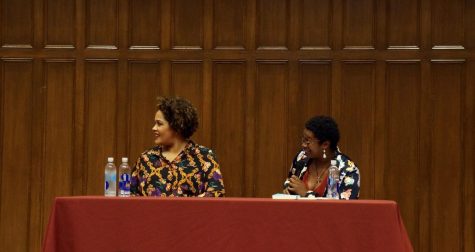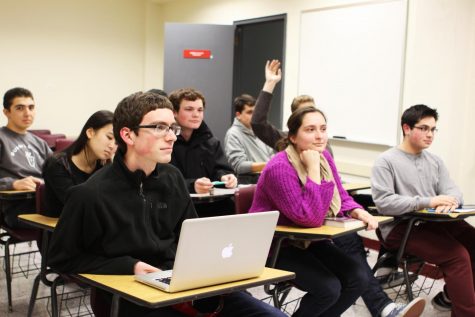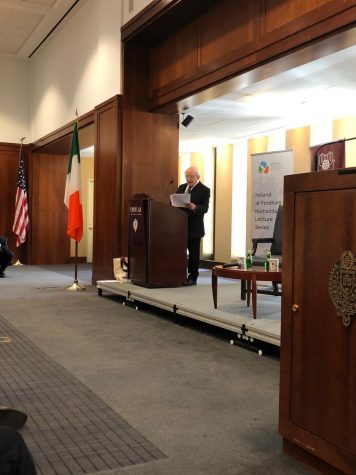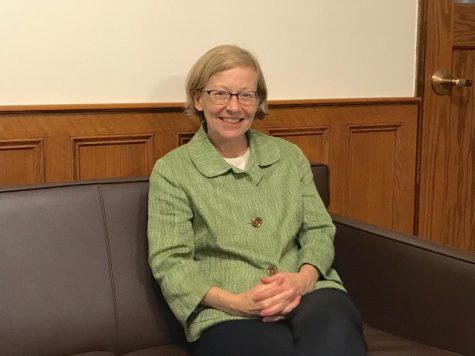Students and Professors Share Thoughts About Online Learning
Many students are bringing the classroom into their dorm room as curriculum moves from the whiteboard onto Blackboard. (Pia Fischetti/The Fordham Ram)
September 9, 2020
The coronavirus pandemic forced Fordham University to adapt in many ways, one of them being the transition to a more online-centered curriculum.
Over the summer, Fordham gathered feedback from over 1,000 students on what worked and what did not work during the sudden switch to remote classes last spring. While over 75% of students said they were either satisfied or extremely satisfied with communication from instructors, many students were dissatisfied with the general clarity and structure of classes as well as with more experiential courses like science labs and performing arts classes, according to Maura Mast, dean of Fordham College at Rose Hill.
Laura Aurrichio, dean of Fordham College at Lincoln Center, said she sees an opportunity here.
“I have been really inspired by the creativity and commitment I’ve seen from so many faculty members and departments who have completely rethought their courses with an eye to taking advantage of the new opportunities offered by this new mode of learning,” she said.
For example, Aurricchio said the art history department has used the new course format to their advantage by changing the normal introductory course to a global art history introduction. Each art history professor had the opportunity to record a video lecture in their geographic area of specialty, which will then be watched by every section of the course, along with a follow-up discussion moderated by their own professor.
The theatre department has similarly used this opportunity as a way to collaborate with other universities around the country like Georgetown and Northwestern.
Natasha Chuk, a professor in the Communications and Media Studies Department, said she also sees opportunity in the new format.
“As a media scholar and practitioner, I don’t find remote instruction inherently inferior to traditional classroom settings, and it can offer some benefits to the learning experience that are missing from conventional approaches,” said Chuk.
She said she believes that both synchronous and asynchronous components are useful for a successful class — synchronous class time provides students and professors with face-to-face discussion, and asynchronous class time supplements this and allows students to make connections and think on their own.
Chuk acknowledged the various difficulties that go along with online classes, such as delayed audio, an unrealistic two-dimensional grid of students and issues with differing internet connectivity. Yet, she said she still finds that in-class discussion is rich.
“Online, there isn’t an equivalent to a front or back row,” she said. “I suppose the grid organization of Zoom and asynchronous participation on Blackboard discussions, for example, are more egalitarian than a large classroom space from a design standpoint.”
Jackie Mutkoski, FCRH ’23, said she is much less nervous to participate in online classes than she normally would be in an in-person class.
“I feel comfortable at home,” she said. “Although I find it easier to get distracted.”
Kelsey O’Brien, FCRH ’23, said distractions at home are a difficult part of online classes as well.
“I miss the physical aspect of being in class with a professor and other students in a traditional classroom setting — I felt like I was engaged and more present,” O’Brien said.
Kara Van Cleaf, a new media and digital design professor at Fordham, said she worries about the differences between in-person and online classes for students.
“I don’t know what the social experience is like for students with remote learning,” said Van Cleaf. “I worry they are missing time before or after class to connect with each other. I’m trying to build that time in, but I realize it’s not that same space.”
Another thing Van Cleaf said she was worried about when deciding whether or not to conduct class online or in-person was the method by which students would physically get to her class. She said she did not want students to feel uncomfortable taking public transportation during a pandemic in order to be able to attend her class.
Mariah Mendez, FCRH ’23, who used to commute to school every day, said she finds both benefits and challenges in this aspect of online classes. Without the need to buy a monthly metro card and a meal plan, she said she is saving money. She said she also now has the opportunity to work in the afternoons since she is not spending that time commuting home after class. However, she said one difficulty is finding ways to socialize with other students.
“I don’t like that I don’t really get to socialize with my peers or make friends, which was already difficult as a commuter,” she said.
Mast said both students and professors are adapting to this environment, and while it can definitely be done, it takes a different approach.
“I worry about what I always worry about, which is that students build connections — to each other and to faculty — and that they will be intellectually challenged,” said Mast.
Both Mast and Aurrichio said that they want to emphasize how available they are to students.
“We are just one email, phone call, or Zoom link away,” Aurrichio said. “Please don’t hesitate to contact us if you have any questions or concerns, or even if you just want to reconnect.”











If you want a picture to show with your comment, go get a gravatar.